|
For the third straight year, lawmakers are trying to raise taxes on alcoholic drinks, in an attempt to reduce New Mexico’s worst-in-the-nation alcohol-related death rate. This time, they just might succeed. New Mexico has the highest rate of alcohol-related deaths in the country. In 2023 excessive drinking killed just under 1,900 people in the state, according to previously unreported data from the health department, about double the national death rate. Powerful lawmakers have said the state needs to act, including House Speaker Javier Martinez, D-Albuquerque, and Rep. Derrick Lente, D-Sandia, who chairs the House Taxation and Revenue Committee. But Democrats, who control both chambers, have been at odds about the best approach, and even the basic purpose of alcohol taxes, despite reams of evidence from across the globe that raising prices deters excessive drinking and reduces injuries and illnesses. The World Health Organization recommends raising alcohol taxes as a “best buy” for reducing deaths due to drinking. In New Mexico, lawmakers have done the opposite, allowing tax rates to fall by more than half since they were last revised over 30 years ago, after adjusting for inflation. During the last two legislative sessions, lawmakers with competing visions for alcohol policy have effectively undercut one another. In 2023 and 2024, a group of legislators co-sponsored bills that would have raised taxes paid by wholesalers of beer, wine, and spirits by 25¢ a drink. Their most recent effort was supported by the New Mexico Alliance of Health Councils, Mothers Against Drunk Driving, and League of Women Voters. But critics assailed the proposal as too large a jump from current rates, which range from 4¢ per drink of beer to 7¢ per drink of spirits. The first time, lawmakers watered down the tax hike to a penny-per-drink increase, which Gov. Michelle Lujan Grisham vetoed. Last year, it foundered in the tax committee, where vice-chair Rep. Micaela Lara Cadena, D-Mesilla, has voiced skepticism that higher alcohol prices deter excessive drinking at all. “We need New Mexico-grown research that understands the complexities of our poverty and our trauma and our truth and can help represent the impact that tax may or may not have on people’s behavior, especially when they’re navigating the disease of addiction,” she said at a December hearing of the Revenue Stabilization and Tax Policy Committee. In the 2024 legislative session, Cadena and another group of lawmakers pushed for eliminating the existing wholesale taxes and levying retailers 3% of alcohol’s sales price. This change would effectively raise taxes on higher-priced drinks, particularly those sold at restaurants, while reducing rates on cheaper drinks. The New Mexico Alcohol Alliance, an industry group that has expressed openness to a “reasonable” increase in alcohol taxes, opposes shifting them to retailers as “an undue burden” on businesses. Debated in lengthy hearings, neither of the competing bills advanced to a floor vote. But in interim hearings throughout the fall, the legislators made efforts to find common ground. Lawmakers who sponsored the 25¢-per-drink tax hike last year have been circulating what they call a “hybrid” bill. It would raise wholesale taxes by 4¢ to 8¢ per drink as well as introduce a new tax on retailers, like that proposed by Cadena, but at a higher 12% rate, the same percentage that cannabis is taxed. By retaining the wholesale tax, the hybrid bill would not allow rates on the cheapest drinks to fall, a distinction the sponsors have previously called “a moral issue.” “The reason I’m co-sponsoring is that if I can add another day, another month, another year to any of my constituents’ lives, that is probably the most important thing I can do,” said Sen. Shannon Pinto, D-Tohatchi, as she presented the bill during the December hearing. The bill would direct a quarter of the $200 to $260 million the sponsors estimate it would raise to the state’s tribes and Pueblos for prevention programs, “including culturally relevant practices.” Native people in New Mexico are less likely to drink than Anglos, but die from alcohol-related causes at much higher rates. Both the Indian Affairs Committee and the Legislative Health & Human Services Committee have endorsed the bill. In a nod to Cadena’s concerns that raising the price of alcohol could inadvertently harm people who are deeply dependent on it, supporters of the bill also suggested funding go to “managed alcohol programs,” which provide clients doses of alcohol in addition to housing and medical services as a form of “harm reduction.” Dozens of such programs have been established, mainly in Canada, and research suggests they are a “promising” intervention for homeless people with severe alcohol use disorder. During the December hearing, Cadena said she was working on her own alcohol tax bill for the 2025 session, but praised Pinto and her co-sponsors for making some compromises, including incorporating a retail tax. She expressed determination to find agreement. “We need to send a bill to the fourth floor,” she said repeatedly. Points of contention remain, including what rate to tax retailers, whether to retain a wholesale tax, and whether to adjust it for inflation. For his part, Lente signaled that both approaches would be debated and voted on as standalone bills, rather than buried in an omnibus tax package crafted behind closed doors. “That’s the commitment that we are making, to ensure that this issue that plagues New Mexico is one that we are taking seriously,” he said during the hearing. “We will send a message to the alcohol industry that we will be taking action in one way or another.” Speaker Martinez also pressured the vying camps of lawmakers to come to an agreement, convening them for a four-hour meeting in early January in hopes of hammering out a single bill, according to multiple legislators in attendance. Alcohol kills more New Mexicans than all illegal drugs combined, and such deaths rose significantly during the COVID pandemic, as they did elsewhere in the country. Now, that pandemic surge seems to be moderating. Between 2022 and 2023, alcohol-related deaths in New Mexico fell 9%, according to the latest data from the health department, but they remained higher than any year before 2020. In other states that have reported comparable data such as Oregon and North Carolina, increases in alcohol-related deaths also accelerated in 2020 and 2021 before slowing or reversing in 2022.
Gov. Michelle Lujan Grisham has not prioritized tackling the state’s epidemic of alcohol-related deaths. In 2021, as many states relaxed long standing restrictions on alcohol deliveries and “to go” sales, New Mexico’s hospitality industry pressed her to sign a bill loosening alcohol sales. She did so over the objections of the state’s alcohol epidemiologist, who said that by promoting drinking the bill “would likely increase harms” including violent crime and child abuse. In 2023, when she vetoed a penny-per-drink increase in alcohol taxes, it disappointed lawmakers and her own former health officials. She instead directed her health department to fund a $2 million Office of Alcohol Prevention. Nearly two years later, of the 11 positions allocated to the department, six remain unfilled.
0 Comments
By Mikayla Ortega
Questa del Rio News Wildfires have been ravaging Southern California since Jan. 7, burning thousands of structures and homes and displacing thousands of people. 24 people have died as of Jan. 15, and the death toll is expected to rise. Due to climate change and increased fire risk, insurance agencies across the country have dropped homeowners’ insurance for people living in ‘high risk’ areas leaving many residents to start at ground zero without so much as the shirt on their backs. Here is our own backyard, the 2022 Calf Canyon fire and Hermits Peak Fire will go down as the largest, most destructive fire in New Mexico history, burning 341,471 acres across San Miguel, Mora and Taos counties. 899 structures were destroyed and an additional 84 were damaged. Fortunately, no lives were lost, however, many families and residents navigated this stark new reality with their homes being destroyed, being left to rebuild from nothing. In our January 2025 issue, we reported that many home-owners received cancellation of insurance policies, while others experienced a steep premium increase due to living in “high fire danger” areas. Insurance agencies are working to respond to the increasingly frequent catastrophic weather events stemming from climate change, unfortunately leaving many uncovered and uninsured when disaster strikes. In our immediate community, as we work to adapt to climate change, Kit Carson Electric is leading the charge in being a socially responsible steward of electricity as it works to advance the Green Hydrogen Project which will effectively make the power distribution and resiliency green. The Cooperative received $231 million in funding to kick off the project from the U.S. Rural Utilities Service under the U.S. Department of Agriculture. This project is the first of its kind in the country, showcasing how the Cooperative will reduce its carbon emissions to minimize the effects of climate change. In response to this funding announcement, Questa local and Kit Carson Cooperative Board Member Bobby Ortega said in a press release on Monday (Jan. 13), “This USDA RUS announcement awarding KCEC $231 million in funding is among the most significant milestones in the coop’s history. This financial award will bring to fruition the first green hydrogen project of this type done by an electric cooperative in the nation,” he said. “The KCEC Board and CEO have an innovative vision for the coop’s future while delivering affordable, reliable clean energy to our members today and well into the future. This New ERA funded project not only allows us to achieve this but also will bring the economic opportunities needed in the Village of Questa, NM and surrounding communities.” While some Questa residents were opposed to the project’s development in the Questa area due to unknown potential dangers and concerns of explosion of hydrogen production, Kit Carson CEO Luis Reyes provided an example of the potential risk and danger in an interview with our publication in our November issue. “Hydrogen is gas. When you drive a car, you’re sitting on a tank of gas which is much closer to you and by the same logic, poses the same danger for explosion– which as we’ve seen is very low,” Reyes said. In addition, Reyes says his team has been working to ensure the project will be in established buildings and facilities left from the former Questa Molycorp Mine to minimize the footprint the project will have on the forested environment in the Questa area. “We are thrilled and extend our gratitude to the USDA for granting this opportunity to our rural electric cooperative in northern New Mexico,” Kit Carson CEO Luis Reyes said. “This will be a game-changer for KCEC, ensuring a reliable power supply even during challenging conditions, and allowing first responders and the community to access life-saving power during emergencies such as wildfires or extreme natural disasters.” The project is expected to produce 350 local jobs during the construction phase and the total tax revenue impact is expected to exceed $44 million over the next five years.Mikayla Ortega Editor, Questa del Rio News ‘We can respect civil rights and protect the right of every family to live safely’ By: Julia Goldberg Source NM “Everyone in this room knows that crime is out of control in New Mexico,” Gov. Michelle Lujan Grisham told attendees to her State of the State address at the Roundhouse on Tuesday. “Even our public safety professionals agree, we’re in a state of crisis…the violent crime rate in New Mexico is twice the national average. Addiction is rampant. And we’re clearly struggling to protect New Mexicans from this madness.” Following a nearly year-long tour of New Mexico to build support for her public safety agenda, the governor on Tuesday laid out several of the proposals she will push lawmakers to adopt during the legislative session that began at noon. Those include toughening penalties for people with felony convictions who illegally possess firearms; sentencing for criminals who traffic deadly drugs like fentanyl; and “civil commitment for those who need treatment the most.” The governor also wants to “reform criminal competency laws that let too many dangerous people remain on our streets.” She will also be pushing for a tax rebate for businesses “to help businesses foot the cost of security personnel and equipment until we can get our crime epidemic under control.” The governor made no mention of yesterday’s inauguration of Donald Trump as president, but ended her speech with a call to action for lawmakers to address crime. “I recognize that the issues that plague us are rooted in poverty, inequality and generational challenges long neglected,” she said in prepared remarks. “But our crime problem destabilizes the very communities we seek to empower; it threatens the very prosperity of our state, in which we have invested so much. We cannot and we must not let this continue. We need the tools to overcome this challenge. We can respect civil rights and protect the right of every family to live safely, the right of small businesses to conduct commerce securely and the right of our children to grow up in communities free from danger.” Following the governor’s speech, Republican leaders in a news conference said they appreciated her new tough-on-crime agenda, which they said they’ve touted for years without any purchase in the Legislature. But they said her speech focused too much on behavioral health spending, which they described as throwing more money at solutions that will be slow to arrive. 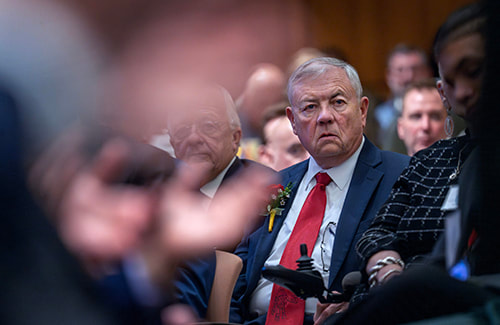 As other applaud Sen. Minority Leader William Sharer, R-Farminton, quietly listens to Governor Michelle Lujan Grisham deliver her State of the State Address before a join session of the House and Senate, Tuesday, January 21, 2025. This was shortly after the start of the 2025 legislative session. (Photo by Eddie Moore / Albuquerque Journal) In a statement provided to Source, Lena Weber, interim policy director at the ACLU of New Mexico, said the organization was “encouraged” to hear the governor’s “commitment to taking bold steps to reduce homelessness and improve access to behavioral health care, describing them as “the real solutions we need to build lasting community safety for all New Mexicans – not more of the same ‘tough on crime’ approach that has failed our state for years.”
However, she said, “we were disappointed to hear the governor yet again propose policies that will fuel mass incarceration in our state and harm our communities. Longer sentences and coerced treatment aren’t the solutions our state deserves. We urge the governor and the Legislature to reject harmful proposals and instead double down on the real solutions that the governor and lawmakers have already proposed that will offer stability and safety by investing in housing, healthcare, education and jobs.” While the governor made public safety and the beleaguered Children, Youth and Families Department centerpieces of her speech, she also touted her administration for its work on the economy and education, reviewed her proposals for schools, housing, climate, jobs and healthcare. CYFD While the governor claimed the state has made progress in CYFD, particularly in the last year, she proposed a partnership with “an independent, outside expert in child welfare and foster care—such as the Urban Institute—to evaluate CYFD alongside the state auditor and make reports to her office and the Legislature every six months.” At the same time, she said she supports an “Independent Child Protection Authority” that will be jointly appointed by her office and the Legislature. The Legislative Finance Committee’s budget recommendations note that New Mexico “consistently ranks among the worst six states for repeat maltreatment occurring within 12 months of the initial allegation, and in FY24 the state’s reported rate of repeat maltreatment worsened.” At the same time, the governor said, the health department is assuming responsibility for the federal Comprehensive Addiction and Recovery Act because “public health experts are best equipped to support families with drug-addicted babies.” Too many families, the governor added, garnering applause, “do not adhere to the spirit of the program. That’s why it’s time to make these interventions on behalf of children mandatory.” She also will back exempting foster families and grandparents raising grandchildren from personal income tax and push to double their stipends up to $900 more dollars monthly. “I say, if you are stepping up for kids in need, we’re going to make it easier for you to support them,” she said. She also urged the Legislature to fully fund CYFD “so it has the resources and personnel it needs to do this important work.” The governor’s budget recommends $286.4 million for the department; the LFC recommendation is $389.4 million. Education The governor said she will propose incentives for schools that ban cellphone use during school hours, “along with funding for enhanced safety measures so that parents don’t have to worry about getting ahold of their kids in an emergency.” She also said lawmakers need to pass a bill to make the state’s Office of Special Education permanent. Another big-ticket item: a $50 million annual investment in the Indian Education Fund. She will also push for $205 million to solidify the state’s free childcare program; a “comprehensive math and STEM program”; and to fully fund 180-day school years. Economy Citing the addition of 134,000 jobs in the past four-and-a-half years, the governor noted that the state has cut its unemployment gap in half over the last two years. The most recent employment gap data available does show gap decreasing, but that appears to be because the number of openings has decreased. The number of unemployed people has stayed largely the same over the last two years. The governor also announced that quantum computing company Quantinuum “is establishing a major research and development presence here in New Mexico.” Climate change Noting the “devastating coverage of wildfires ravaging Los Angeles,” the governor also acknowledged the fires that have “ravaged communities in our state, testing our patience and resilience as we struggle under the weight of natural disasters in our backyards.” Moreover, she said, “getting insurance protection is becoming impossible, either because it’s simply no longer available or exorbitantly expensive.” To that end, the governor said she’ll propose a state-sponsored fire insurance program “outside the private market…to help make people whole when tragedy strikes.” The state does currently offer insurance as a last resort to those who have been denied in the private market, through its so-called FAIR plan. The state’s insurance regulator is seeking $50 million to expand that program during this year’s session. The governor also re-upped her proposal for a Strategic Water Supply. “Our state, like so many others, is facing a severe water shortage, and climate change is only making the problem worse. Yet we have enormous reserves of brackish water lying beneath our feet. And we have massive amounts of industrial water that is being injected right back into the ground. Let’s build the technology to clean up that industrial water rather than pollute our aquifers.” The proposal has garnered opposition from environmentalists. NM Attorney General Raul Torrez Releases Guidance On Immigration Enforcement For Community Leaders1/22/2025 DEPT. OF JUSTICE NEWS RELEASE
Los Alamos Reporter In response to President Trump’s executive order rescinding longstanding federal protections for sensitive locations such as schools, churches, hospitals, and courthouses, the New Mexico Department of Justice (NMDOJ) has issued guidance to leaders of these critical spaces. This change in policy, reversing safeguards recognized by both Republican and Democratic administrations, underscores the urgent need for local leaders to understand their rights and responsibilities at the intersection of state and federal law. The removal of sensitive location protections overlooks the vital role spaces like schools and hospitals play in supporting families and children. Disruptions in these places can jeopardize access to education, healthcare, and essential services, leaving families in crisis without the stability and support they need. The NMDOJ’s guidance is a vital resource to ensure these spaces remain accessible and welcoming for families and children while maintaining compliance with the law. “Our priority is to protect New Mexico’s families, especially children, from policies that create fear and destabilize communities,” said Attorney General Raúl Torrez. “We are committed to upholding the rule of law and ensuring public safety, but we must also safeguard the ability of families and children to access education, healthcare, and justice without fear of persecution.” “I support enhanced border security and targeted enforcement operations focused on cartel members, violent criminals and anyone who represents a national security risk to our nation,” Attorney General Torrez added. “But rounding up children, crime victims and sick people is beneath the dignity of a great nation.” The publications released today also provide critical guidance in the wake of the Trump Administration’s unlawful threat of federal prosecution to force state and local officials to use their limited resources for immigration enforcement. “Threatening state and local officials with federal prosecution not only distorts the law but stains the reputation of a once proud institution,” said Attorney General Torrez. “As a former federal prosecutor who handled hundreds of immigration related cases, I know that this not only a distortion of our laws but a shameful departure from the proud traditions of an agency that is supposed to be dedicated to the advancement of justice.” The guidance is designed to mitigate the chilling effects of immigration enforcement actions on individuals seeking essential services. The documents offer practical strategies for minimizing disruptions while adhering to state and federal laws. Key components of the publications include: Judicial Protections: Outlining the Fourth Amendment rights of individuals, emphasizing the distinction between administrative and judicial warrants, and clarifying protocols for managing immigration enforcement activities in public and nonpublic areas of court facilities. Community Safety: Addressing the impact of enforcement actions on victims of crime, including domestic violence survivors, and highlighting protections under the Violence Against Women Act (VAWA). Collaboration with Leaders: Encouraging schools, healthcare providers, and places of worship to develop policies that balance legal compliance with the need to maintain safe and welcoming environments. For more information or to access the full list of guidance publications, please visit: Guidance on Immigration Enforcement – New Mexico Department of Justice By Zach Hively Images Courtesy of Zach Hively An ode to not staining clothes with chile This poem came to mind recently for a simple reason. When I feel overwhelmed with the state of the world and everything in it, it’s easy for me to get caught up in too much wide-ranging thinking. What helps me is focusing, if only for a moment, on something as simple as breakfast. Or as peculiar as another human being. Perhaps it’s a meditative act. Perhaps it just brings me back to my five (or more) senses and reminds me to breathe, to eat, to be present—without any of which I can’t do a darn thing about anything else in the world. Look at Him
He is a museum piece sitting down to breakfast. Hair combed with pencil lead, shirt pressed from canvas, eyes crinkled in clay. Instead of him you see the dedication of his earthen self to this day. Instead of him you see the ablutions required just to sit down a clean slate to a plate of red chile and a cup of black coffee. Instead of him you see the inevitability that canvases must be painted and foreshadows come to fruition. His every bite a tightrope act, and you would drop coins in his hat for the performance for his cool dedication for making you feel the primal wonder that anything could happen and this time, you might be there to see it. He sops up the chile, swipes the plate with a tortilla, and before the unthinkable inevitable happens the waitress clears the stage. He’ll be back, tomorrow and the morning after that, hair combed with pencil lead and shirt still pressed from fresh canvas. You’ll see. A Santa Fe artist’s studio is hosting a “pottery throw down” on Feb. 7 to support Española Humane’s work and invite the public to celebrate.
Hosted by Paseo Pottery and Española Humane, the Pottery Throw Down fundraiser features live pottery demonstrations, wheel-throwing and hand-building activities, music and tasty libations. It’s from 6-8 p.m. Friday, Feb. 7, at Paseo Pottery, 1273 Calle de Comercio in the Rufina neighborhood. Española Humane will have a dog ambassador to greet the public, along with information about its lifesaving programs, including free spay/neuter surgeries, vaccinations, adoptions, transports, Paws in the Prison and care for animals in need. Cost is $25, with proceeds benefiting the shelter. All ages are welcome. Space is limited. To register, visit https://paseopottery.as.me/THROWDOWN
Interview with Birgitte Ginge
By Jessica Rath It doesn’t stop to amaze me that a tiny village in New Mexico, one of the least populated states in America, attracts so many people not only from all over the U.S. but from across the globe. One of them is Birgitte Ginge who used to be a Danish citizen but now lives in Abiquiú, for over twenty years (and has dual citizenship). I was curious: what brought her here? She kindly agreed to an interview.
Birgitte was born in Odense, one of the oldest cities in Denmark. She told me that it is named after the Nordic god Odin, and that it celebrated its thousandth anniversary in 1988, although some settlements in the area date back more than 4,000 years, to the Stone Age! With a population of about 185,000 people, it is Denmark’s third-largest city.
She grew up in a beautiful part of town; there was a river close-by, and living as she does now right by the Chama River, often reminds Birgitte of her happy childhood. There were walking trails everywhere; one could walk into the downtown area along ponds, lakes, and meadows. If you’ve ever visited a medieval-looking European town, you might wax nostalgic remembering streets with cobblestones, picturesque half-timbered houses, and steep-overhanging roofs.
Odense is well known for being the birthplace of Hans Christian Andersen, world-famous author of fairy tales such as The Little Mermaid and The Ugly Duckling. Younger generations may know his stories only from Disney movies where they were sanitized and sweetened – I highly recommend going to the library and getting a volume of Andersen’s fairy tales. They’re touching and full of wisdom, and some of them are sad – but in a good way.
Birgitte went to Odense University where she received her Ph.D. in archeology. After she had finished her doctorate, she spent some time in Rome doing research, publications, and studies, and from there she went to Cambridge University on a post-doctoral fellowship. Next, she came to the United States – “It was supposed to be a one-year fellowship at Princeton University, and that's almost 40 years ago,” she told me. I asked about the principal object of her work as an archeologist. “I did some excavation, but most of my research was centered on already excavated material and was taking place in museums. My focus was on the Etruscans. I've worked in almost every major museum in Europe. The British Museum, the Louvre, Berlin Charlottenburg, the Vatican, wherever there was something that fell within my field of interest or expertise, I traveled to those places. Same in this country, I have worked in a lot of different museums in connection with Etruscan pottery”, Birgitte explained. “After I was done with my Princeton fellowship, I taught at Rutgers University, did research at the University of Pennsylvania, and then I was teaching at Dickinson College, Gettysburg College, and Franklin & Marshall College, all in Pennsylvania. I did that for about 10 years, and then I wrapped up my academic career by being the Assistant Provost of Gettysburg College.” After she met her partner, Birgitte moved to Phoenix/Arizona because that’s where Madeline Williamson was a professor and piano teacher at the School of Music at Arizona State University. Birgitte’s archeological career came to an end because there wasn’t any job available in her field. “But at that point I was almost 50 years old, and it was okay to try something else”, she told me. “It opened a new chapter in my life, and I took a job with Borders Books, which was a hot thing at that time in the 90s. Borders was the place to be. And so I was a bookstore manager for some years, until we moved to Abiquiú. After we moved here, I got a job at the Santa Fe Opera from which I retired after almost twenty years.” Of course I wanted to know: what made them decide to move to New Mexico, and especially to Abiquiú? “Well, it was probably by chance,” Birgitte answered. “We were traveling home from vacationing with friends in Colorado, and we decided to take a different route from Gunnison in Colorado to Phoenix, Arizona, by way of New Mexico. We headed for Santa Fe after we had spent time in Chama where we visited the Narrow Gauge Railroad. Driving from Chama to Santa Fe we came through Abiquiú, and we stopped to check it out. We had a meal at the Abiquiú Inn, and the Abiquiú Realty was right next door. We looked at some of the offerings and decided to spend the night at the Abiquiú Inn. We checked out some properties, and before we knew it, we had an appointment with a real estate agent and came out here in November of 2000. We bought the property right away.” Birgitte continued: “We didn't move here immediately, but in 2003 Madeline decided that it was time to take early retirement, and so she set that in motion, and we had friends who wanted to buy our house in the historic district in Phoenix. So by Memorial Day of 2004 we arrived in Abiquiú.” And how did you decide on the architect? Your house is so unusual. “There's Dwell Magazine, which is fairly well known for contemporary architecture,” Birgitte explained. “They had just started in 2002 or 03, and we were interested in contemporary architecture and design, so we took a subscription, and there was an invitation to architects around the country to submit designs for prefabricated housing.” You can read more about the house at the magazine’s website.
“There were about ten architects, and we interviewed with a firm in San Francisco who were to become our architects for the project,” Birgitte continued. “ They’re two brothers of Norwegian descent. We had very much the same kind of esthetic, and they quickly understood what we wanted. The house was for two people to live in, with a lot of animals, so they needed to design porches for the cats and kennels for the dogs. And we told them that we wanted music. So from the very beginning, the performance space was part of the design.”
“The architects came out to visit the site before they did the design, and they really understood and appreciated the location: the bend of the river with upstream and downstream views, and the island out there in the middle. It was their idea to build the house up a little higher, because they are environmentally conscious. Prefabricated was part of the design, and they decided that a small footprint was less invasive for the environment and benefited the location. In September of 2006 the house was ready for us to move in.” Here is the Abiquiú House at the architects’ website. I always admired the light-filled weightlessness of the house. There are hardly any walls inside, and most of the structural walls have floor-to-ceiling windows. The few doors there belong to bathrooms, for privacy. Inside the house one almost feels as if sitting on a cloud with views of the sky, the river, and an endless parade of wildlife: ducks and geese, eagles, deer and elk, an occasional beaver. And inside one always found a number of cats and dogs, all rescued. The design of the house includes several living areas for these animals: two big fenced-in porches where the dogs had plenty of space to run around but were safe. At night they went into their crates in the “pet apartment”. The cats were indoor cats but they could spend outside-time on one of the big decks which was enclosed with a chain link fence. The idea of designing a house and deliberately including living spaces for lots of rescued animals – I can’t think of anything more praiseworthy.
“Once we had seven dogs and seven cats at the height of the population at the same time, and they all had their separate living spaces. Some of them got along better than others, so we had to keep them separate. But they all had their safe and secure areas,” Birgitte added.
Next, I asked Birgitte about the Chamber Music Festival which was already part of the design for the house before they even moved here. “Yes, we didn't know exactly what, but we wanted to offer performances for the local community. By the time we came out here and the house was built, Madeline decided that she wanted to have a New Music festival. So we thought about New Music. Basically, what was envisioned as a New Music festival became a regular chamber music festival where we offered both new music and traditional classical music. I think it really worked well, because people loved coming to hear Mozart and Haydn and Beethoven, but they also were eager to learn something new. And a lot of people in our local and supporting community really thought that probably the new music was the major part, because they learned so much, they took away so much from each concert.” I remember that they often had young composers there, and I asked Birgitte about this.
“Absolutely,” she replied. “Young composers and young performers were there right from the beginning. We didn't know what to expect for the first season, but once we had a foothold and the reputation, we knew people would be coming. Madeline would bring in soloists and major artists from all over the country and from all over the world. Some came over from Italy several times, and we had some Russian and some Chinese artists, and we had some local collaborative musicians.”
I wanted to know– how did you find the more famous musicians, such as the pianist from Italy, Emanuele Arciuli? Birgitte explained: “Madeline just went online to look for people who were doing interesting performances and were well-known performers in their field. Emanuele had been coming to the United States and New Mexico for a few years, but he didn't really perform much here. So she just brought him in. The same with Matthew Aucoin, for example, a young composer from New York who won the MacArthur Fellowship (called the genius grant) in 2018. So Matthew was here before he was truly famous. And now he's very famous.”
That sounds fantastic. Which brought me to more questions: how did the festival grow over the years? How many people attended a concert during its twelve seasons? Did you always have a full house?
“We could seat 100 people, and there weren't 100 for each concert in the first season, but I would say there were probably between 50 and 70,” Birgitte told me. “We never advertised, it was all word of mouth. We left postcards at the post office, hung posters in local businesses, but we never paid for advertisements at all. I would say over the years about 7,000 people walked through the front door to hear music.” “It went on for twelve years. It started in 2008 and then the last season was 2019. Of course, we didn't know that COVID was going to happen, but Madeline got a medical diagnosis in 2019 that made us decide that we couldn't continue with the festival. As it turned out, we would have had to discontinue anyway.”
At the same time, Birgitte was also working at the opera. Those summers must have been busy!
“Yes, during the season, it's pretty intense to be an employee at the Santa Fe Opera”, Birgitte confirmed. “We had six concerts here. Every other Sunday from mid June through mid August we had concerts. So yeah, I didn't really have time off in the summer but I was working every day. Having a concert here basically meant that you got up in the morning and you just started with the setup and the planning and everything getting ready. And of course, there had been rehearsals at the house for a couple of days before, they usually came out on Friday to rehearse, sometimes also Saturday, and then gave the concert on Sunday. There was always a reception for the supporters, the donors, and the musicians as well.” “Plus, we had to find accommodation for the artists. Luckily, the community was very supportive. A lot of bed & breakfasts around here donated overnight stays for the artists. That was an extra draw, because they loved to come out here and just stay at a bed & breakfast. And then there was fundraising, and I did that as well. During the off-season, I raised money.” I remembered that: there were silent auctions and things like that. “Yes, silent auctions, art shows at Abiquiú Inn, plus, we had good support from our local communities. And in the end, I also managed to get some grants. I raised about $50,000 a year to make the concerts happen and to pay the musicians.”
I had to ask: did you ever make a penny from all your endeavors?
Birgitte chuckled. “No, this was for the good of the community. We had a lot of expenses in the beginning because we had nothing, no funds to start with. Everything – buying the umbrellas and the chairs and everything else, it all came out of our own pockets. But eventually we could break even. Once we got started and had some ticket revenue, once the fundraising was going well, we could raise enough money. The art shows were really important in the beginning, because they provided a lot of money that we wouldn’t have had otherwise.” This is so impressive – Birgitte and Madeline produced all of this out of nothing. There was no precedence, there was nothing to base it on. It just all started and grew into this really fantastic thing. “Yes, we had only just arrived and the house was barely completed when we started that first summer. You don't know how many people are going to show up. It was very much of an experiment but it really paid off.” Birgitte continued: “People loved it because it was in person. It is such a different experience when you can be with the musicians. And sometimes we had the composers here too. For example, Jennifer Higdon had the premiere of her opera Cold Mountain at the Santa Fe Opera, and so we performed her piece, and she came out and enjoyed it, and people got to meet her.” I remembered another award-winning composer, Ingrid Stölzel. She was from Germany. “Yes, Madeline found her online and really liked her music, so we commissioned a piece from Ingrid, and it was performed, and she was here for the world premiere.” And then there was the classical music composer Ruth Lomon, a friend of Madeline’s I believe. She attended several Abiquiú Chamber Music Festival seasons before she passed away in 2017.
What an impressive legacy. I’m sure that everybody who was able to attend a concert or a whole season has fond and priceless memories. My warm gratitude to Birgitte for opening her house to us, and for letting us look behind the scenes of the Abiquiú Chamber Music Festival. For a taste of the music, please play the YouTube video below.
Marie T. Pearlingi, LMT Right at Home Massage LLC. NM MT9497 Online at rightathomemt.com (505) 209-0152 (New Number), [email protected] Really, it’s a thing. We spend an inordinate amount of time on our phones, laptops, and desktops whether it’s required or not. Why? Well, it’s fun! There is an unbelievable amount of information to be found on our technology, including this article I’m writing, and the corroborating information found elsewhere. So, what is it and how do you know if you have it? Well, neck pain for one. But it also can affect your upper back and your shoulder girdle aka the rotator cuff. Let’s start first with the head which weighs, on average, 10 lbs. Your 10lb. head is being balanced on a narrow stack of bones and is supported by many muscles and tendons. Picture a bowling ball resting on a fat marker (just to simplify) attached to a bunch of rubber bands of various thicknesses, lengths and strengths. For every inch that that bowling ball drops in any direction, that is an additional 10 lbs. that those rubber bands must support. If you are looking down at your phone and your head is leaning forward 3 inches, that’s 30 lbs. your neck muscles are holding. If you hold it steady for any significant amount of time (like a YouTube rabbit hole) those muscles will begin to tire and get sore. The fun thing about the neck, though, is that there are itty bitty muscles that will remember that position and will begin to like it, so they will stick in that position. Eventually, their little muscle friends will follow, and you will feel discomfort when you decide to move in a different position. Finally, the shoulder girdle. By now, I think you have it. Staying in one position causes forward rotation. Muscles get tight and cause discomfort. If it’s left to its own devices, it can eventually lead to dowager’s hump (humpback) when those muscles lock up and there is nothing that can be done to help. So, what can be done? Before you go and schedule surgery, a lot of this pain can be resolved with massage therapy. Why not a chiropractor? Chiropractors specialize in the displacement of bones. Why are the bones displaced? Because of tight muscles. Chiropractors often employ massage therapists for this reason. When used in conjunction, this is a best case scenario. My business model is to help people feel better in the comfort of their own homes. My price is reasonable. I have been a massage therapist for over 25 years and have worked on thousands of people. Massage therapy is one of those gifts that doesn’t collect dust and makes people feel better. Interested? Give me a call or text at (505) 209-0152 or shoot me an email at [email protected]. I’m looking forward to meeting you (or seeing you again)!
AKA, I'm carding what friends I have left. By Zach Hively Despite any previous claims I have made to the contrary, I have actual friends all over this country. All over the world! That way, I know I am loved in several time zones, but I don’t have local people infringing on my free time for frivolous activities like “birthday parties” and “driving you to the airport” and “being there for you when you need emotional support.” All the maintenance required for friendships abroad is the biannual phone call or email. For those, you don’t have to put on going-out clothes or find parking downtown— you can sit at home in your scuzziest pajamas and decide partway through the process to wear no clothes at all. This is extra true when you don’t use FaceTime. Essentially, long-distance friendships enable me to enjoy all the benefits of being alone without any of the crippling drawbacks of loneliness. It’s a perfect setup—or so I thought. You see, everything has a cost. The cost of my friendship strategy is that correspondence takes time. And I always have something else to do with my time. Things like, saving the nation from runaway fascism. I’ve started to suspect that, by gum, I am the one person on this earth with the smarts, the looks, and the God-given destiny to stop the insanity that’s happening so fast that no single individual can keep up with all of it. I mean, I see all kinds of ways out of this. I just need Congress to listen to me, and the state governors, and the National Guard, and NASA, and an assortment of woodland creatures. I’d have the whole kerfuffle dusted by Valentine’s Day. If not this year’s Valentine’s Day, then certainly some year’s. But then I decide to read the internet. That’s when I get downhearted. All … this … might just be shiny head fakes designed to distract us plebes from the actual shifts in power structure that will ultimately send us spiraling into a world where we’d consider cannibalism a reasonable alternative to swallowing this much doodoo. Taking on the new world order makes me tired. So I take lots of naps. And when I wake up to discover that nothing has changed for the better, that makes me really, really, really want to talk to my friends. Except that I know we’ll just end up rehashing the latest madness. And like I said, I have lots of other things to do with my time. Like writing Christmas thank-you notes. These glittery, wintry cards have been sitting in their original packaging on my coffee table since December. And not the most recent December, either. You may be thinking that I should just pick up the phone and call my friends and family to say thanks. Maybe have an actual conversation while we’re at it. But why do that when I can send them a card? A card is a tangible representation of my affection. A card also says, “Hey, friend and/or family member, you are special enough that I don’t want our conversations to be electronically traceable in any way.” That’s right: in these recent times, I have become a paranoid survivalist. I don’t want the government and other billionaire-run organizations tracking any of my activities, even if it’s just me thanking my grandpa for sending me a check instead of wrong-size socks. I don’t want the wrong people knowing where I shop, where I hike, who I talk to, or how much time, exactly, I spend reading listicles instead of working.
Basically, I am taking preemptive action here. The only way to stay entirely safe is to cease to exist. I mean, crazed fans aren’t lining up to assassinate Meat Loaf, amirite? But isn’t that exactly what they want, the people you know who I’m talking about? To divide us, to isolate us? That’s what will happen when we choose to live in fear and submission. And the antidote to division—isn’t that connection? Connection doesn’t have to be on a large scale. Million-person marches. Grand demonstrations. It can also be two people who genuinely care about each other sending notes in the mail, calling each other just to say hi. Even if they end up discussing the Atwoodian amusement park at hand—isn’t open communication precisely what brings us together? So that’s it. No more excuses. As an act of compassion and resistance, I’m going to call my friends. Right away. No stalling for nothing. I mean it. As soon as I figure out how to tie off this piece. Thank you for being a paid subscriber to Zach Hively and Other Mishaps. Want to subject your friends, neighbors, in-laws, or other annoying people to the same things you endure? Please share this post. In which I, for some reason, am trusted as a film critic. By Zach Hively Have you ever experienced the joy, the admiration, the raging jealousy of watching someone you love on stage or screen? I haven’t. (Kidding! Of course I have. I absolutely adored my little sisters’ school symphony concerts and didn’t ever even once snore.) But I got to, recently. I watched a screener of the new movie Laws of Man, and there, right there, was my beloved home state of New Mexico, playing the role of Nevada and maybe also of Utah—convincingly so, I might add, especially if you’ve never been to Nevada or maybe also Utah. This isn’t the first such time I’ve felt such pride. I’ll always remember how 2000s Albuquerque played a fine 1980 El Paso in No Country for Old Men. And it had a shining, starring role as itself in the docudrama Breaking Bad. This may not mean much to you New Yorkers and Hollywood types, but I, an informal member of the New Mexico press, am happy to qualify to review this movie based on my geography alone. And I will say this with confidence: It is, in fact, a movie. Here’s the premise:It’s 1963 in Nevada. It’s also 1963, we presume, in Utah. Two U.S. Marshals, played by the well-typecast Jacob Keohan and Jackson Rathbone, must serve a warrant on Benjamin Bonney (Dermot Mulroney, who you have seen somewhere before and you’ll spend the movie trying to remember where). It seems ol’ Bennie is murdering anyone who lives near his Nevada ranch and burning their houses down, then buying up their land at a pittance. But arresting B.B. is more complicated than the marshals expect. For starters, some flashbacks to Frank the elder marshal in World War II keep getting in their way. So do all the characters one expects to see in a town with a motel but, as far as we know, no houses: the sassy prostitute, the gentle barmaid with more going on than meets the eye, the too-cool itinerant preacher parked in an Airstream. Then the villains are pure storybook. The Bonney clan lack their daddy’s screen presence but make up for it with ominously biblical names: Noah, Ahab, and Joe. (In my defense, I thought it was Job for three-quarters of the film.) The throwaway bad guys who open the film have teeth rotting out, and they drool spittle, and they are called the Crash Mooncalf Gang, after their founding member, Moonraker. No, wait. That’s not right; Roger Moore wasn’t James Bond until the 1970s. Yet despite all the stock characters, this—as Frank tells his younger, brasher partner, Tommy—“this isn’t a cowboy movie.” “Yeah, well. Sometimes a cowboy’s what you need,” Tommy fires back. (Unspoken, but implied: “You know, like when the cattle are straying and you’ve got some beans that ain’t gonna eat themselves. You packin’ a harmonica there, pardner?”) Now, no spoilers, because frankly you wouldn’t believe me if I told you. I guess I should have put more stock in the straight-outta-Fleming villain name at the start, because there’s something fishy going on here turns real quick into a volcano-lair-level climax—but unlike a Bond-level resolution, the ending to Laws of Man is shaken, not earned. It could have been earned, though. This is what breaks my moviegoing heart. At one point, the trippy itinerant preacher (Harvey Keitel) asks Marshal Frank why he ended up at this motel. “It’s the only motel in fifty miles,” Frank says. “It was this patch of concrete or a tent.” Frank—or rather, Frank’s writers—chose not to go with Option B. This was the great mistake. Had they stuck the marshals in a tent, this whole thing would have been a whole lot campier. This reviewer, for one, could have gotten really into this flick if it had leaned into the camp already there. Campiness would have allowed them to heighten the tropes, and thereby justify them. Let the lawmen and the villains be bigger than life. Let the caricatures know they are affects. Let this ridiculous and ginned-up ending feel right at home, inevitable, instead of what-the-hellable. Either that, or lean hard into the people and forget shooting for orbit. Laws of Man was never going to be Oscar bait. But not every movie needs to be. Not every movie can be. I sometimes forget that there is cinema beyond the blockbusters. Films on low budgets. (Low in movie terms; I could still live on one of these budgets quite without complaint.) Directors trying things out and getting creative. There’s an immense freedom in blowing single-digit millions instead of three-digit millions, and in these movies we might see more of what artists really want to make instead of what executives think might sell. So I can admire Laws of Man for that. And for showing true love for the genre in places. But I can’t feel that it succeeded. Like Frank, torn between playing it straight and taking justice into his own hands, it didn’t choose a direction and commit. The real reason why the film doesn’t bring it all on home is perhaps right there in the script: “It doesn’t make sense,” Frank says of the case, but arguably also of the conclusion he senses coming. “It doesn’t have to.”
Not even New Mexico’s rock-solid performance can overcome that. Laws of Man, directed by Phil Blattenberger, is available in select theaters and on select digital streaming platforms. |
Submit your ideas for local feature articles
Profiles Gardening Recipes Observations Birding Essays Hiking AuthorsYou! Archives
October 2025
Categories
All
|

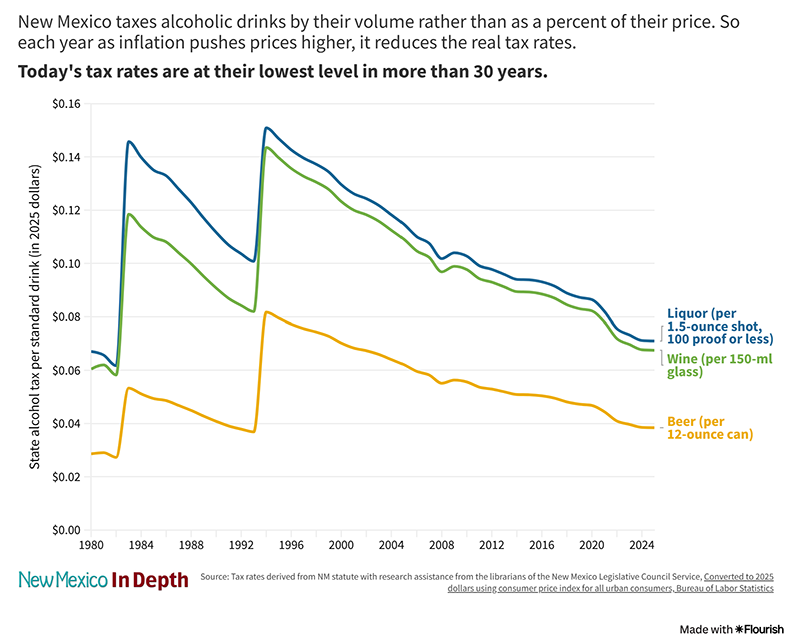
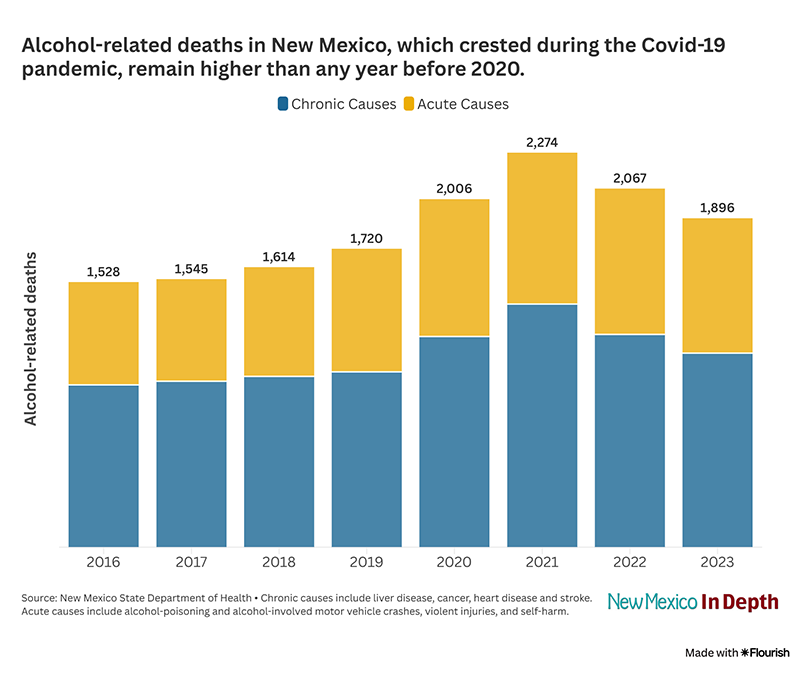
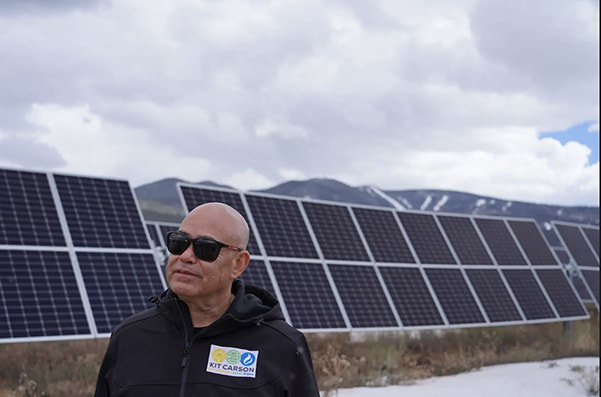
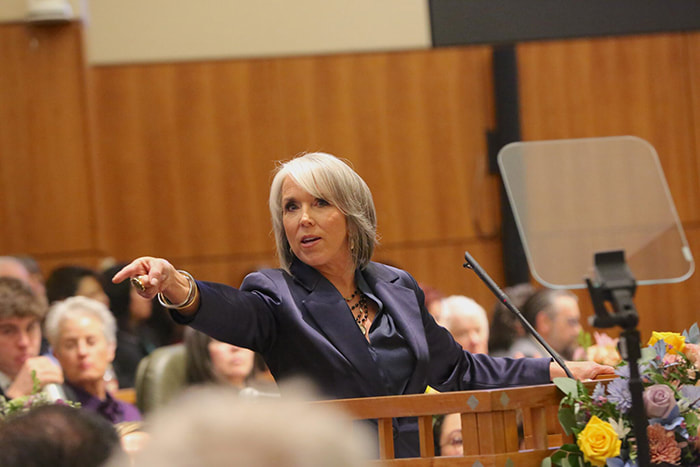



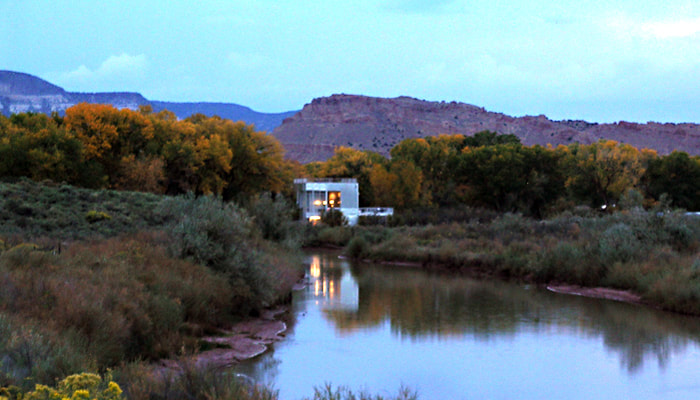

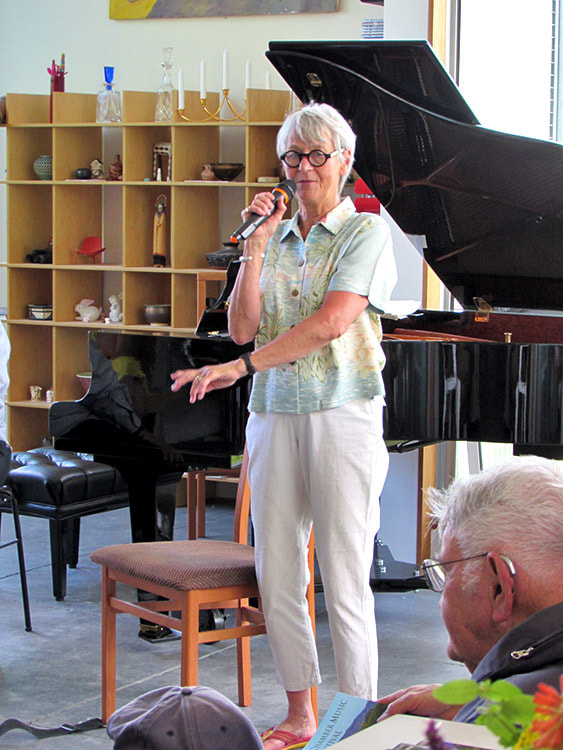

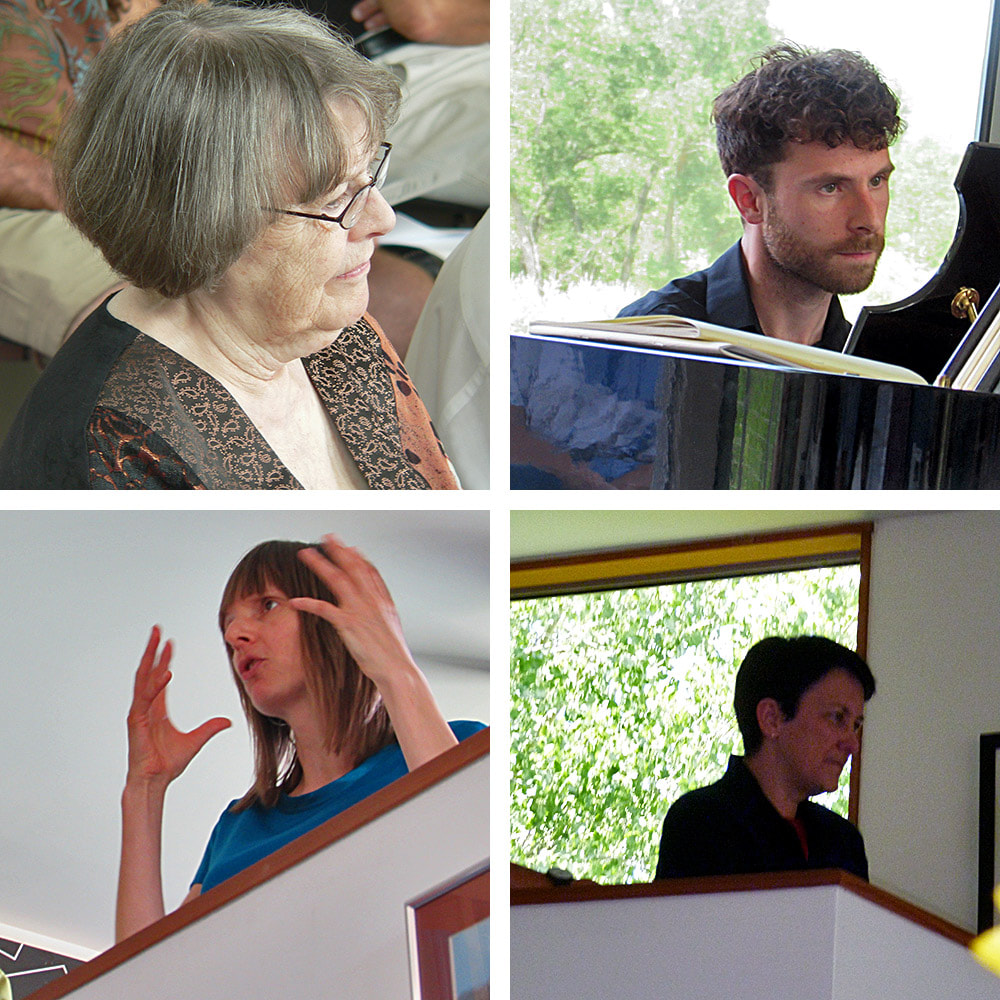
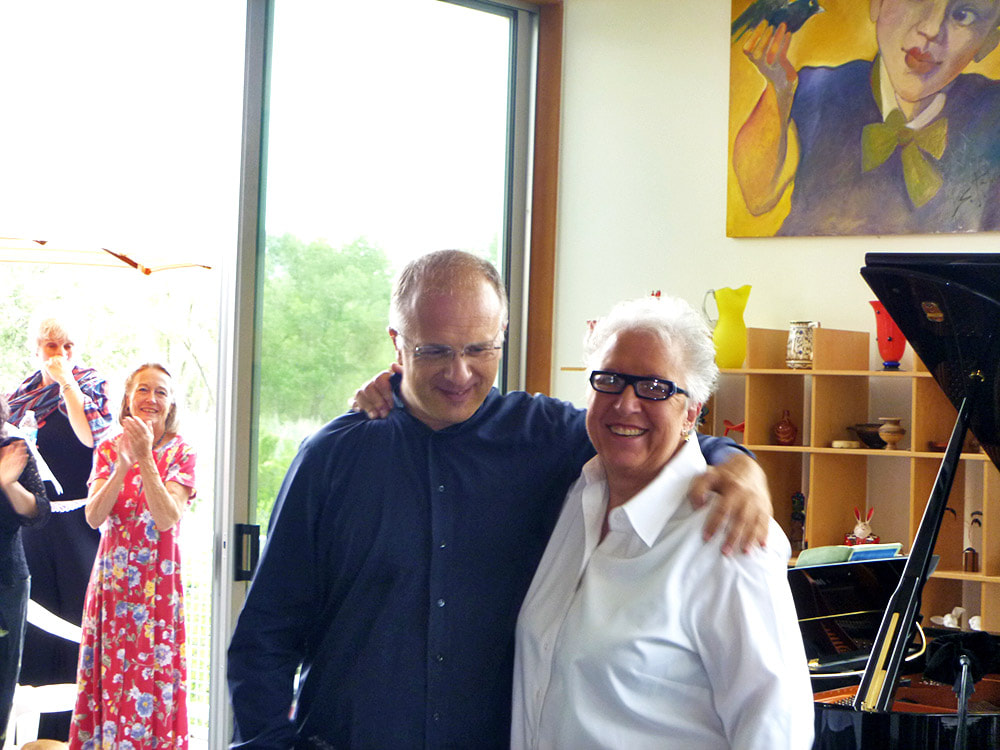
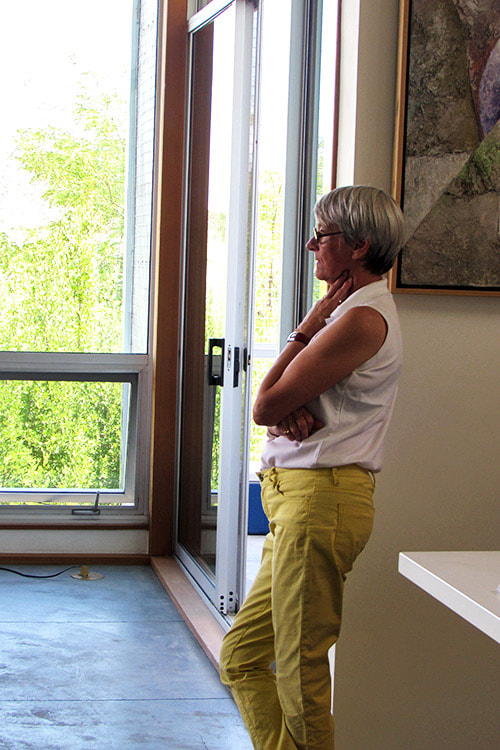

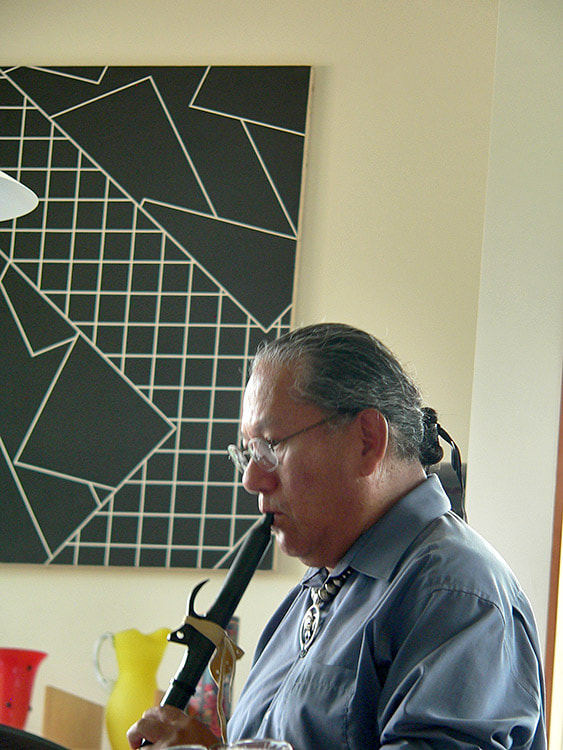



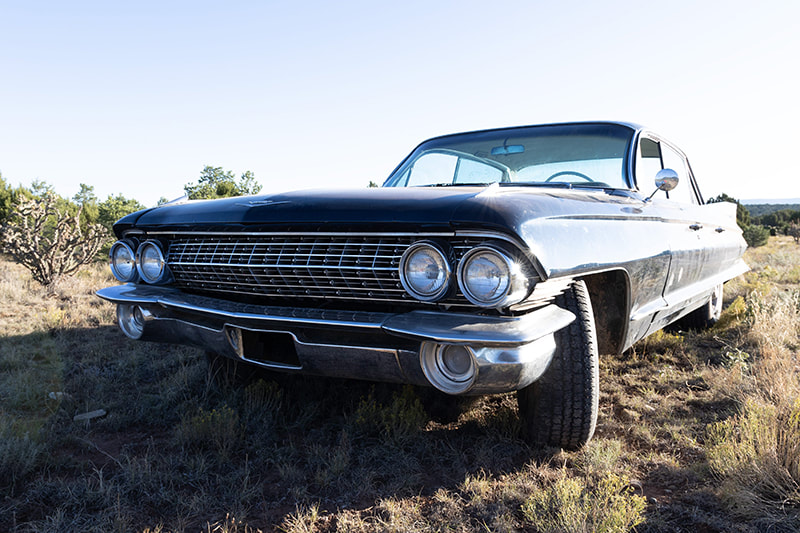


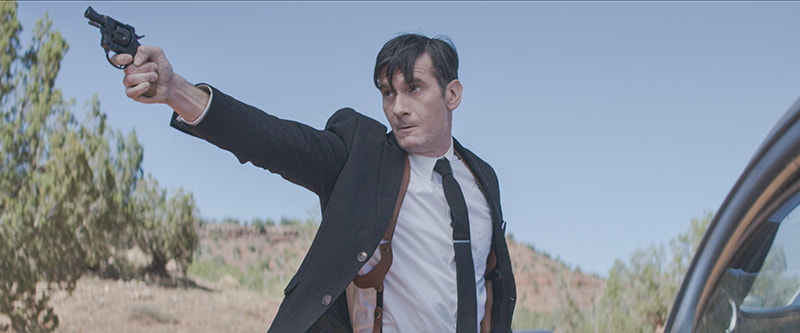
 RSS Feed
RSS Feed